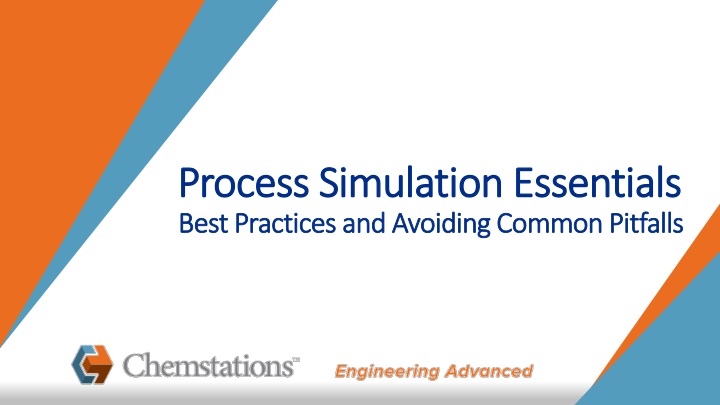Essential Insights into Process Simulation and Best Practices
Explore the key functionalities of process simulators in engineering, including calculating heat and mass balances, providing vital data for simulations, and facilitating facility optimization. Discover best practices to ensure accurate modeling and effective utilization of process simulators for various engineering tasks.
Download Presentation

Please find below an Image/Link to download the presentation.
The content on the website is provided AS IS for your information and personal use only. It may not be sold, licensed, or shared on other websites without obtaining consent from the author.If you encounter any issues during the download, it is possible that the publisher has removed the file from their server.
You are allowed to download the files provided on this website for personal or commercial use, subject to the condition that they are used lawfully. All files are the property of their respective owners.
The content on the website is provided AS IS for your information and personal use only. It may not be sold, licensed, or shared on other websites without obtaining consent from the author.
E N D
Presentation Transcript
Process Simulation Essentials Process Simulation Essentials Best Practices and Avoiding Common Pitfalls Best Practices and Avoiding Common Pitfalls
How can we help more? If there are additional topics within the presentation slide deck or the simulation examples that you would like to see addressed, let us know. If you would like to share any materials you have with other professors, Chemstations can be either a reference or a repository.
What are we going to cover today? What does a process simulator do? Best practices Common mistakes
What does a process simulator do? Calculate heat and mass balances around unit operations & whole processes Calculate what happens with vapor, liquid, solid in unit operations: cooling, heating, separating, or changing phase
What does a process simulator do? Calculate heat and mass balances around unit operations & whole processes Calculate what happens with vapor, liquid, solid in unit operations: cooling, heating, separating, or changing phase Provide key information for calculation: Databank with physical properties of chemicals Thermodynamic models for vapor-liquid equilibria Mathematical models for common unit operations
What do engineers do with process simulators? Model existing facilities Single unit or whole plant Troubleshoot issues Optimize energy/material use & costs Increase throughput Study what happens if conditions are different Connect to control system for monitoring/control Design new facilities
Best Practices Start with good physical property data Choose & validate your thermodynamic model Build model one step at a time Handle recycles with care
Start with Good Physical Property Data Which heat capacity curve is correct? Heat capacity: experimental vs predicted 55 50 45 Cp (Btu / lbmol*dF) 40 CP A CP B 35 30 25 20 0 20 40 60 80 100 120 140 Temperature (dF)
What is good physical property data? Operational data is great Pilot plant data is good Lab data is OK Literature data is . . . sometimes not bad Predicted data is . . . brave
How do you choose your thermo model? Experience with thermo is necessary Articles/books can teach you basics Compare to data for important systems
Validate Your Thermodynamic Model Inspect TPxy diagrams Run some flash calculations & inspect results Have a qualitative idea of what the phase separation will look like
Start Simple 2 1 1
Put In a Good Initial Estimate Specify this flow rate to stabilize calculations! Let the simulator calculate this flow rate.
Common Mistakes Matching plant data How accurate are the measuring devices? Last calibrated? Were all measurements taken at same steady-state conditions? Are you ignoring trace chemicals? Neglecting to examine different conditions (cooling water can average 90 F in Houston summer)
Other Common Mistakes A simulator is not a video game Converged doesn t mean correct Understand your process before modeling If you don t know what you re doing, you ll get the wrong answer These are tools; you are the engineer Garbage in = garbage out Use engineering judgment, not necessarily default options
Takeaways from Today Process simulators are powerful tools to help make it easier to solve a wide range of engineering problems You will encounter these tools when you graduate & should become familiar with them Like any tool, it s important to know how to properly use it to get the best results
Learn more! Use a simulator to revisit homework problems! Find a mentor! Find examples! Learn TPxy plots . . . applied thermodynamics . . . Read a book! Edwards, Chemical Engineering in Practice, Kindle edition Seider, Lewin, Product and Process Design Principles Kaes, Refinery Process Modeling Read a magazine article!























